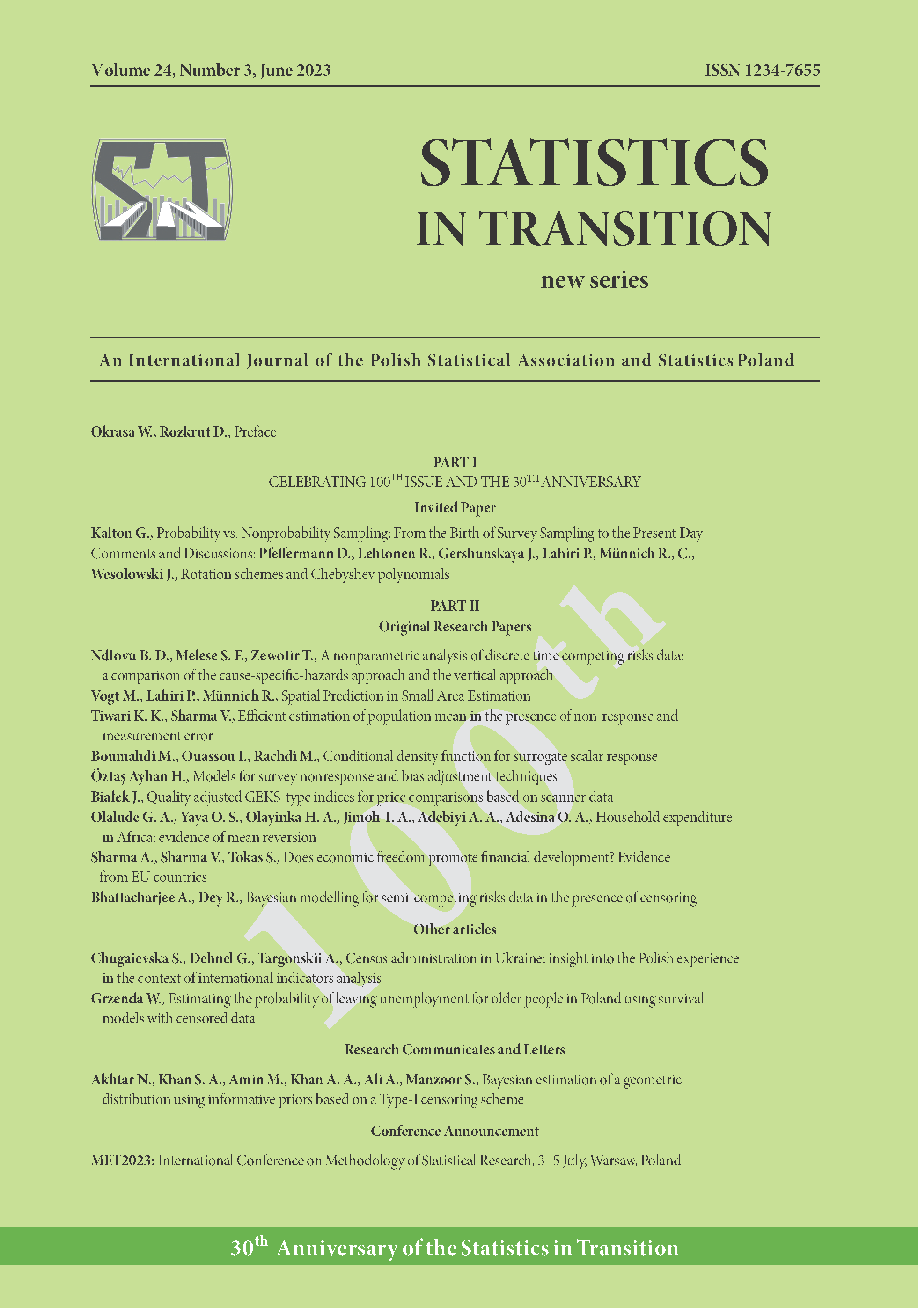G. A. Olalude, O. S. Yaya, H. A. Olayinka, T. A. Jimoh, A. A. Adebiyi, O. A. Adesina. Article available under the CC BY SA 4.0 licence
![]()
ARTICLE
ABSTRACT
This paper investigates the mean reversion in household consumption expenditure in 38 African countries; the expenditure series used were the percentage of nominal Gross Domestic Product (GDP), each spanning 1990 to 2018. Due to a small sample size of time series of household expenditure, with possible structural breaks, we used the Fourier unit root test approach, which enabled us to model both smooth and instantaneous breaks in the expenditure series. The results showed non-mean reversion in the consumption expenditure pattern of Egypt, Madagascar and Tunisia, while mean reversion was detected in the remaining 35 countries. Thus, the majority of African countries are on the verge of recession once shocks that affect the growth of GDP are triggered. Findings in this paper are of relevance to policymakers on poverty alleviation programmes in those selected countries.
KEYWORDS
household expenditure, poverty level, mean reversion, Africa.
JEL
C22; D19; H31
REFERENCES
African Development Bank, (2012). A Comparison of Real Household Consumption Expenditures and Price Levels in Africa. Tunis: African Development Bank.
Akhand, A., (2011). Household Consumption Behaviour in Indonesia, Newcastle Business School, The University of Newcastle The University Drive, Callaghan, NSW 2308, Australia.
Awolaja, O. G., Yaya, O. S., Vo, X. V., Ogbonna, A. E. and JOSEPH, S. O., (2021). Unemployment Hysteresis in Middle East and North Africa Countries: Panel SURbased Unit root test with a Fourier function. Middle East Development Journal, pp. 13 (2), 318–334.
Becker, R., Enders, W., and Lee, J., (2006). A stationarity test in the presence of an unknown number of smooth breaks. Journal of Time Series Analysis, 27(3), pp. 381–401.
Ben, E., (2015). A test of the household income process using consumption and wealth data, European Economic Review, http://dx.doi.org/10.1016/ j.euroecorev.2015.05.003.
Box, G, E. P., Jenkins, G. M., Reinsel, G. C., and Ljung, C. M., (2015). Time Series Analysis: Forecasting and Control. John Wiley & Sons, UK.
Enders, W., Lee, J., (2012a). A unit root test using a Fourier series to approximate smooth breaks. Oxford Bulleting of Economics and Statistics, 74, pp. 574–599.
Enders, W., Lee, J., (2012b). The flexible Fourier form and Dickey-Fuller-type unit root tests. Economic Letters, 117, pp. 196–199.
Furuoka, F., (2017a). A new approach to testing unemployment hysteresis. Empirical Economics, 53(3), pp. 1253–1280.
Furuoka, F., (2017b). Unemployment Dynamics in the Asia-Pacific region: A Preliminary investigation. The Singapore Economic Review, 62(5), pp. 983–1016.
Fumitaka, F., Pui, K. L., Ezeoke, C., Jacob, R. I. and Yaya, O. S., (2020). Growth slowdowns and the middle-income trap: Evidence based on new Unit root framework. The Singapore Economic Review. https://doi.org/10.1142/ S0217590820500083.
Gil-Alana, L. A., Yaya, O. S., (2021). Testing Fractional Unit Roots with Non-linear Smooth Break Approximations using Fourier functions. Journal of Applied Statistics, 48 (13-15), pp. 2542–2559
Giray, G., (2013). Stochastic properties of the consumption-income ratios in Central and Eastern European Countries Zb. rad. Ekon. fak. Rij., vol. 31, sv. 2, pp. 193–207
Lozano-Gracia, N., Young, C., (2014). Housing Consumption and Urbanization. Policy Research Working Paper., 7712, pp. 4–5.
Mahdavi, D. B., (2013). The Non-Misleading Value of Inferred Correlation: An Introduction to the Cointelation Model. Wilmott., 1, pp. 50–61.
Nik, M., Nik, H.R., Noorhaslinda, A. and Nasir, A. (2011). Household Income and Expenditure Relationships: A Simultaneous Equation Approach. Chinese Business Review, ISSN 1537-1506. pp. 395–405.
OECD, (2020). Household Spending (indicator). DOI: 10.1787/b5f46047,
Thankgod, O. (2014). Private Consumption Expenditure Function in Nigeria: Evidence from the Keynes' Absolute Income Hypothesis.
Yaya, O. S., Furuoka, F., Ling, P. K., Jacob, R. I. and Ezeoke, C. M. R. (2020). Investigating Asian Regional Income Convergence using Fourier Unit Root test with Break. International Economics, 161, pp. 120–129.
Yaya, O. S., Ogbonna, A. E. and Mudida, R. (2019a). Hysteresis of Unemployment rate in Africa: New Findings from Fourier ADF test. Quality and Quantity International Journal of Methodology, 53(6), pp. 2781–2795.
Yaya, O. S., Ling, P. K., Furuoka, F., Ezeoke, C. M. R. and Jacob, R. I. (2019b). Can Western African countries catch up with Nigeria? Evidence from Smooth Nonlinearity method in Fractional Unit root framework. International Economics, 158, pp. 51–63.
Yaya, O. S. (2018). Another Look at the Stationarity of Inflation rates in OECD countries: Application of Structural break-GARCH-based unit root tests. Statistics in Transition new series, 19(3), pp. 477–492
Yaya, O. S., Otekunrin, O. A. and Ogbonna, A. E. (2021). Life Expectancy in West African countries: Evidence of Convergence and Catching up with the North. Statistics in Transition, 22(1), pp. 75–88.
Zivot, E., Andrews, D. W. K. (1992). Further evidence on Great Crash, the oil price shock, and the unit root hypothesis. Journal of Business and Economic Statistics, 10, pp. 251–270.
